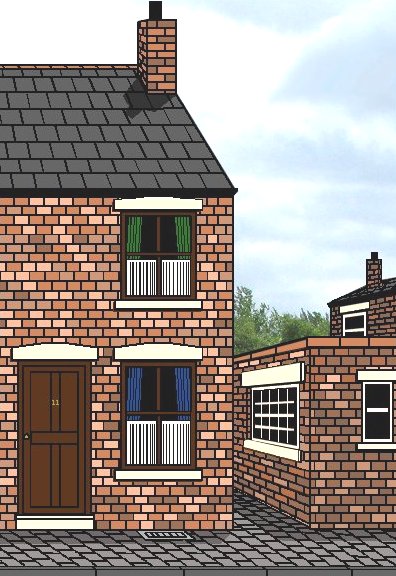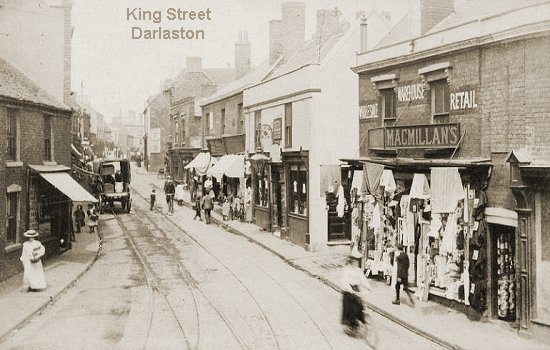|

Number 11 Factory Street, a
typical house in the area. |
Many of the houses were still
without a mains gas supply and so oil lamps had to be
used at night. They were hung from the ceiling and often
filled the rooms with an unpleasant acrid smell. Soot
from them would be deposited on the ceiling above,
eventually producing a black mark. Often just a single
lamp would be used upstairs, usually hanging from the
landing ceiling, so as to illuminate the stairs, and
light the bedrooms through open doors.
Coal fires were an essential part
of life, and the chairs in the sitting room (often the
kitchen) would be arranged around the fire in order to
get the most benefit from it.
Coal was delivered by the coal man
in 1cwt sacks, and tipped into the cellar through the
coal hole, or stored in a coal house, or coal place as
it was sometimes known. It would be stored in piles,
each consisting of lumps of the same size. Bundles of
kindling wood made from
off-cuts could be cheaply purchased from many shops, and were often stored with the coal.
Everyday, a bucket or coal scuttle would be filled and
placed by the fire in readiness for use. The grate was
swept clean with a small brush to remove any ash from
the previous day’s fire, and a few crumpled newspaper
pages and criss-crossed pieces of kindling wood were
positioned in the centre. They were covered with smaller
lumps of coal, known as “slack”, and larger lumps were
placed around them. The paper could then be lit to start
the fire. |
| Often a coal shovel would be fanned in front of the
grate to produce a draft to draw air over the fire to
quickly get it going. Lighting a coal fire is a
practiced skill, something that we have almost forgotten
today.
Throughout the evening, as the fire burned, other
pieces of coal would be added. The quality of the coal
could vary considerably. Good black coal often burned
better, and at a higher temperature than the browner
Lignite. Sometimes small pieces of fossilised leaf, or
other stony material would be embedded in the coal. When
they heated and expanded, they could shoot out of the
fire and possibly put a burn mark on the carpet. Often a
mesh fire guard would be used to prevent this, and also
to keep small children safe from the fire. The larger lumps of coal,
often including bits of shale were known as “bats”. |

King Street, from an old postcard.
| A large blazing fire would more
than adequately heat a whole room, but as the evening
progressed the state of the fire greatly changed. Later
in the evening when much of the coal was consumed, the
temperature would fall. Because of this people tended to
sit around the fire, and their rooms were laid out
accordingly. Occasionally the chimney sweep would be
called to sweep the chimney and remove the soot which
was a fire hazard. Soot burning in the chimney could
cause a lot of damage, and a large build-up of soot
could fall down the chimney and blacken everything in
the room below. Coal fires were dusty and dirty and so
rooms had to be dusted and cleaned more frequently than
today. Bath night usually occurred once a
week because a fire had to be made to heat the water.
People bathed in a tin bath, either in the brewhouse or
in front of the fire in the kitchen. Because of the time
taken to heat the water, the same water would often be
used by several people, and topped-up with hot water as
necessary. |

A podging tool. Courtesy of Beryl Jones.
|
Carpets were a luxury. They were
usually podged rugs (sometimes called bodged rugs) that
were hand made using strips of old material, threaded
through a course Hessian backing with a podging tool,
consisting of a steel rod with a hook at one end and a
wooden handle at the other. Most of the family joined in
the rug-making which could be a good way to while away
the long winter evenings. An old sack would be saved and
washed to form the backing and a podger could be made
from half an old clothes peg. They often used darker
material which did not show dust and dirt, and sometimes
formed a pattern from several colours. The finished rug
would take pride of place in front of the hearth and
would be a treat to walk on, especially when compared
with the cold quarry tiles that frequently covered the
floors.
Cooking was a very different
process to what we know today. Some families were lucky
as their houses were connected to the gas supply, and so
might even have a gas cooker. Most would cook on the
kitchen range, having to cope with the vagaries of the
fire and the changing temperature. Pots would be hung
over the fire, or placed in the small oven that usually
formed part of the range. The fire also heated the
kitchen, often the only heated room in the house, which
usually doubled as the living room.
Some food would be washed and
prepared at the sink in the brewhouse, before being
carried into the kitchen to be cooked. Fruit and
vegetables were seasonal and so homemade preserves such
as jam and pickles were an important part of the diet.
Food was stored in the pantry, a
dry, cool, and dark room, with a large stone slab and
plenty of shelf space. If you didn’t have a pantry it
could be stored in the cellar, which would be
partitioned to separate it from the coal. Many families
kept chickens in their back yard to provide them with a
frequent supply of eggs, and meat on special occasions. |
 |
|
 |
|
 |
Return to
Woman's Work |
|
Return to
the contents |
|
Proceed to
Hobbies etc. |
|